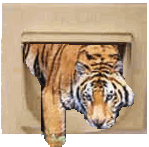Cat flaps
In British English they are called 'cat flaps'; in American English they are 'kitty doors'. In each case, they are hinged entrances which can be fitted to a door, window, or wall. Their purpose is to allow the cat to enter the house without needing a human to open the door. Legend attributes the invention of a cat flap to Sir Isaac Newton. Apparently he was a cat lover and did not want to restrict the access of his cats a to any part of the house. This included the dark room in the attic where he carried out optical experiments. Sir Isaac made an opening in the atic door by which the cats could come and go as they pleased. Actually he made one big hole for the mother cat, and, deciding he had made it too high, a smaller one for the kittens. Since letting light to the dark room would have ruined his light experiments, he hung a black velvet cloth over the openings, thus creating the first ever cat flap.
If this is so, the invention had to wait a considerable time for the name to be recognized, as the Oxford English Dictionary, has the first record of the expression 'cat flap' being used 1957, so the adoption of the idea seems to have been rather slow.
A simple cat flap consists of a weighted flap which swings backwards and forwards. These days many have a small magnet attached to the bottom to stop the flap swinging in the wind. Other flaps have adjustable catches to allow restricted access. For example, to keep the cat indoors during the night you can set the flap to close, so if the cat is already outside the house it will be able to enter, but will not be able to leave again.
More sophisticated cat flaps have electromagnetic catches which only open if the cat has a matching magnet worn on its collar. State-of-the-art cat flaps have infrared sensors which are set to a specific code send by the transmitter on the cat's collar. The idea of a selective cat flap goes back to a model designed and patented by Paul Pedrick. His invention was designed to detect the difference in the fur colour of his ginger moggie and that of the black cat next door. He then thought through the implications of the technology, and had it patented. His patent, number GB1426698, was entitled: "Photon Push-Pull Radiation Detector For Use In Chromatically Selective Cat Flap Control And 1000 Megaton Earth-Orbital Peace-Keeping Bomb". The patent consisted of two parts: the first one referring to a cat flap application and the second dealing with the means for an intelligent bomb in orbit to detect whether a nuclear attack had been made on the surface of the Earth below it, and to determine from which part of the Earth's surface the attack had originated. The patent was granted in March 1976.

The wrong cat flap can allow strange cats into your house.
Pros and Cons of a cat flap
The big advantage of a cat flap, apart from preventing nuclear armageddon, is the fact that a cat can have a free access to the garden without the help of a long-suffering human doorman. However, there are also disadvantages. For example, many cats learn quite quickly how to open an one-way flap by pulling at the bottom of the inner flap. Cats like bringing trophies (mice or birds) into the house, and having a cat flap, there is less control over their movement, and a higher chance of gruesome trophies being discovered within the house. (Or worse, of the little corpses not being discovered for several days or longer.)
But perhaps the biggest problem can arise when the house is invaded by a strange cat. At the end of August 2006, an English newspaper "The Eventing Standard" reported on a vicious cat called Grumpy which terrorised the good folk - feline and human - of London. The cat would sneak through the cat flap into people's houses and scare off the cats who lived there. When the surprised owners returned home Grumpy would go into attack mode and launch himself at them, casing nasty injuries in many cases. After days of search he was finally trapped by RSPCA. Although this is an exceptional story, it really reinforces the fact that an open cat flap is an invitation for strange cats to come and help themselves to any food they can find. But although undesirable, this is not the major problem. Cats are very protective of their territory, and once their home is invaded they will try protecting it. This may involve a direct fight with the invader, or an attempt warn the invader that this is their territory by spraying it comprehensively with their urine. Animal behaviourists believe that indoor spraying may often be directly linked to the presence of a cat flap and a subsequent lowering of the cat's feeling of security while indoors. Bear in mind that even if your cat's collar carries more electronic gadgets than Terminator II, this won't help your cat feel more secure. All she knows is that if she can get in through the cat flap, other cats can too, and they need to be warned off by a sophisticated mix of scent and pherenomes utilizing a liquid delivery vector - i.e. pungent cat pee.
